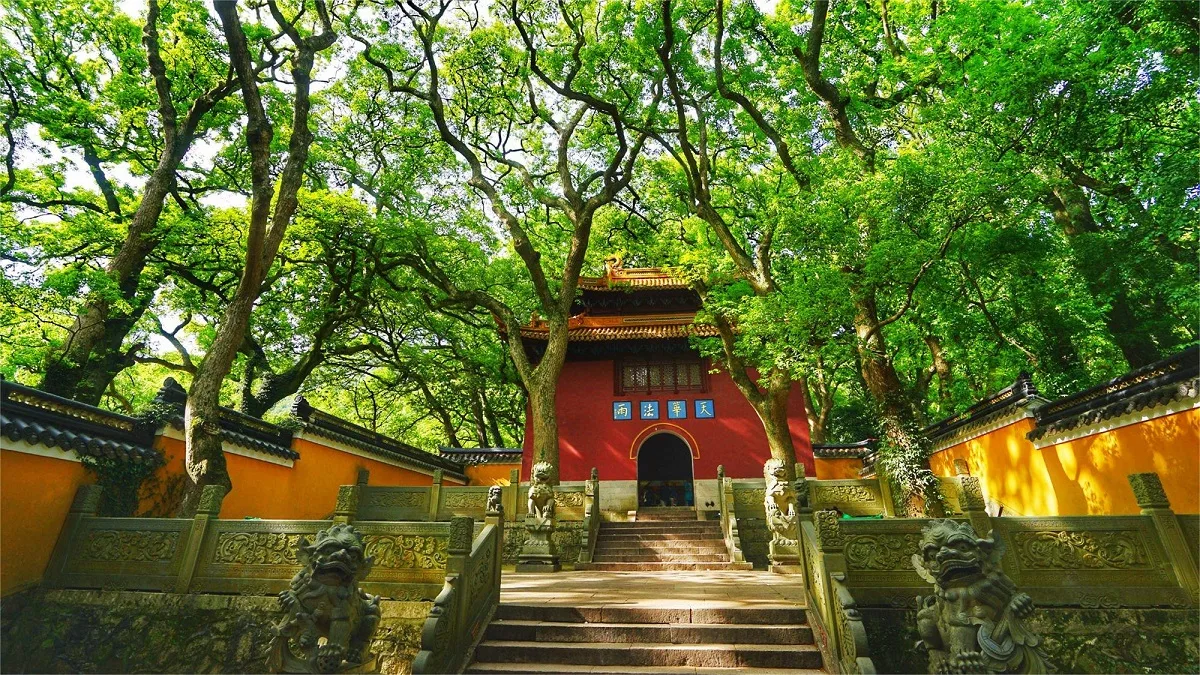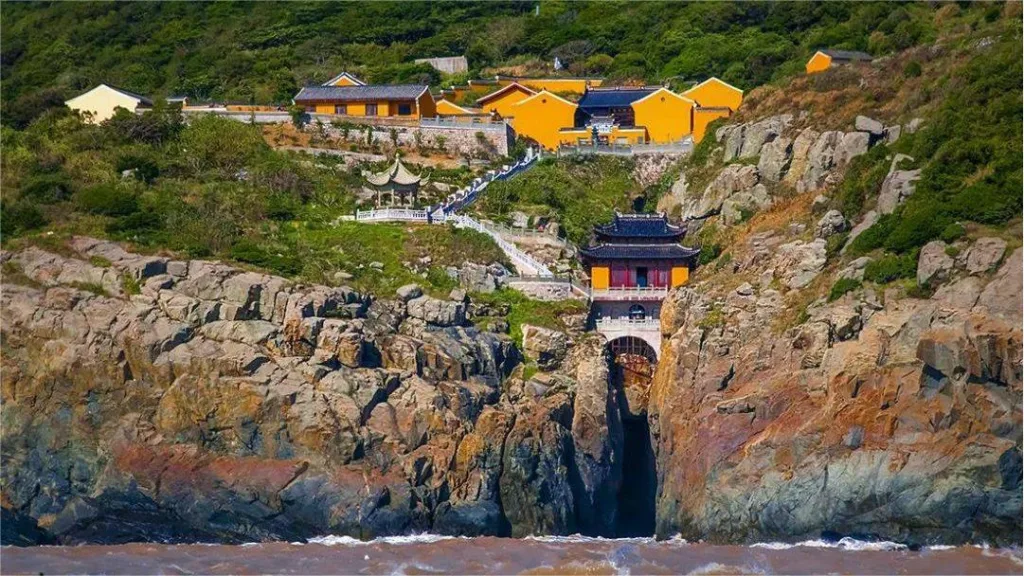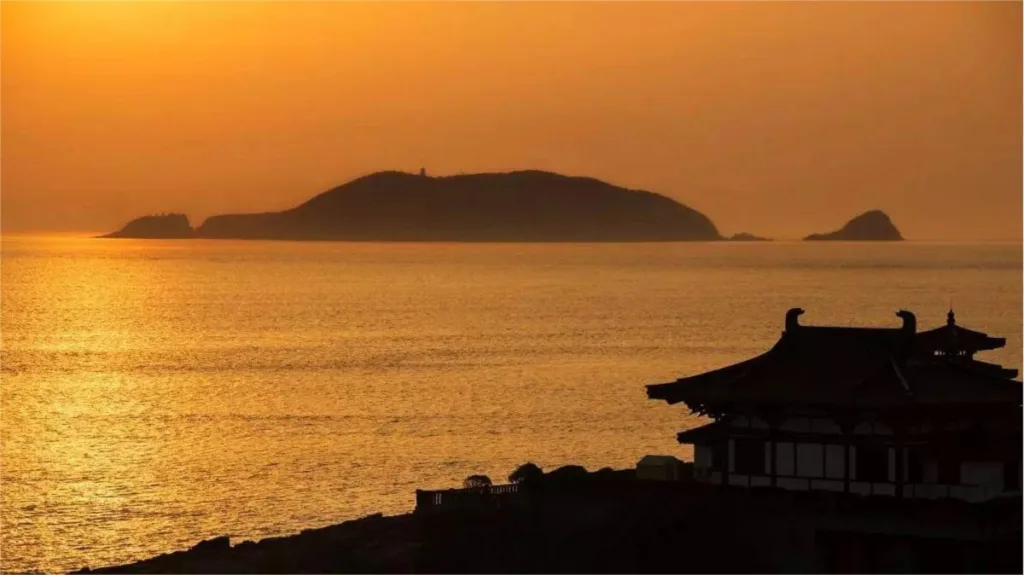Fayu Temple (法雨寺), also known as the Rear Temple, is one of the three major temples on Mount Putuo, located to the left of Baihua Peak and beneath Guangxi Peak. Covering an area of 33,408 square meters, the temple comprises 294 existing halls and rooms, arranged across six terraced platforms, following the natural contours of the mountain.
Entering through the main gate, visitors ascend progressively higher terraces. Along the central axis, the Tianwang Hall is first, followed by the Jade Buddha Hall. Between these two halls stands the Bell and Drum Tower. Further along are the Guanyin Hall, Yubei Hall, the Grand Hall of Great Sage (Mahavira Hall), the Sutra Library, and the Abbot’s Hall.
The Guanyin Hall, also known as the Nine-Dragon Hall, is renowned for its exquisite and lively carvings of nine dragons. The hall’s dragon caisson ceiling and some of its glazed tiles were relocated from a Ming Dynasty palace in Nanjing, making it one of the three treasures of Mount Putuo.
The entire temple complex is grand and serene, exuding an extraordinary aura. Nearby, the expansive Thousand-Step Beach provides a sense of openness and tranquility, with the sound of waves crashing day and night, adding to the temple’s serene and sacred atmosphere.
Table of Contents
- Basic Information
- Location and Transportation
- Highlights of Fayu Temple
- Vlog about Fayu Temple
- History of Fayu Temple
- Other Attractions on Mount Putuo
Basic Information
| Estimated Length of Tour | 1 – 2 hours |
| Ticket Price | 5 RMB |
| Opening Hours | 6.00 – 18.00 |
| Telephone Number | 0086-0580-6690480 0086-0580-6690540 |
Location and Transportation
Fayu Temple is situated on Mount Putuo, located to the left of Baihua Peak and beneath Guangxi Peak, approximately 2.8 kilometers from Puji Temple. To visit Fayu Temple, visitors should first reach Mount Putuo. From there, take the No. 2 bus and get off at the Fayu Temple stop.
Highlights of Fayu Temple
Nine-Dragon Avalokitesvara Hall

Among the various buildings within Fayu Temple, the most magnificent is the Nine-Dragon Avalokitesvara Hall, also known as the Grand Yuantong Hall. This hall, constructed in April of the 38th year of Emperor Qianlong’s reign during the Qing Dynasty, is the highest-specification Buddhist hall in Chinese temple architecture. The hall was built using materials from the demolished Nine-Dragon Hall of the Ming Palace in Nanjing.
The hall spans seven bays, reaching a height of 22 meters, a width of 35.35 meters, and a depth of 20.31 meters, covering an area of 957.96 square meters. It features 48 columns and employs an intricate wrapping and inlay technique. The hall has a double-eave glazed tile roof, with nine brackets on the upper eave and five on the lower eave. Inside, the hall boasts an exquisite Nine-Dragon coffered ceiling. One dragon coils at the top, while eight other dragons, with their heads raised and claws extended, encircle the eight columns, creating a beautifully ancient and elegant design.
At the center of the hall sits a 6.6-meter-high statue of Pilu Avalokitesvara. The back wall showcases a large-scale depiction of Avalokitesvara on a sea island, surrounded by the 53 encounters of Sudhana and flanked by statues of the Eighteen Arhats. The columns and bases inside the hall are adorned with dragon relief carvings from the Wanli period of the Ming Dynasty, characterized by their bold and vigorous style.
Nine-Dragon Wall
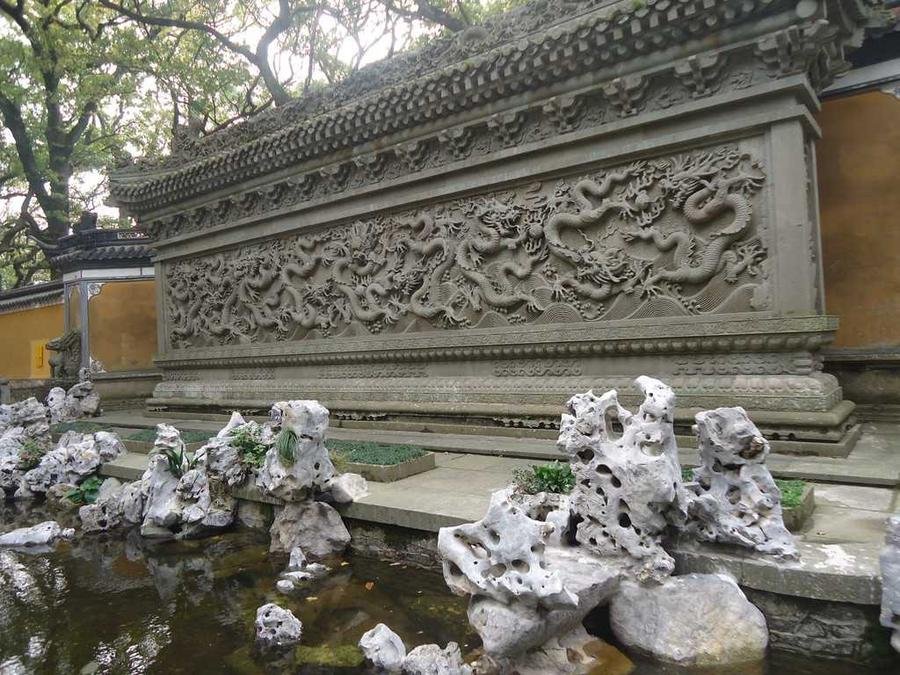
Opposite the Hall of Heavenly Kings, a stunning Nine-Dragon Wall can be found. Completed in 1987, this wall differs from the ceramic Nine-Dragon Walls found in the Forbidden City, Beihai, and Datong. Instead, it is composed of 60 green stone slabs, each measuring 70 centimeters square, meticulously carved and seamlessly joined to appear as a single large stone slab.
The wall stands 2 meters high and 12 meters long, with a relief depth of 16 centimeters, creating a striking three-dimensional effect. The base features a Qing-style Sumeru pedestal, with flying eaves and upturned corners adorning the top. Seventeen small dragons, each with a unique design, are carved between the stone beams and tiles. The central section of the wall depicts nine dragons, each with raised heads and outstretched claws, flying among clouds and seas, vying for a dragon pearl in a vivid and lifelike manner.
This Nine-Dragon Wall was crafted by local stonemasons from Changyu Town, Wenling, Zhejiang Province, under the direction of the Mount Putuo Buddhist Association. The project was funded by donations from Hong Kong compatriots and executed by master stone carver Liang Zongtao and his team, who replicated the style of Beijing’s famous Nine-Dragon Wall.
Exquisite Natural and Artistic Features
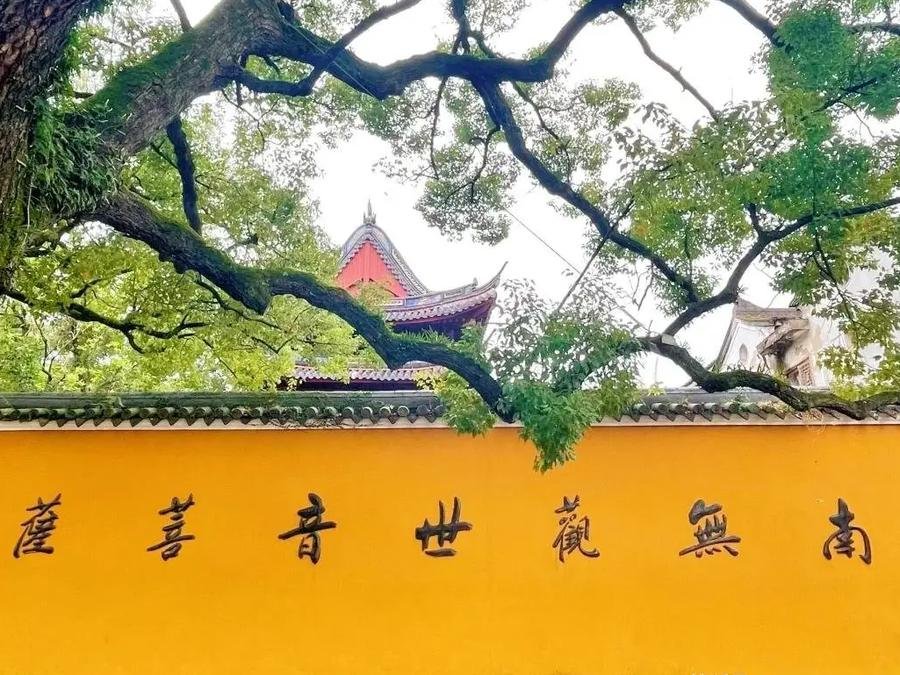
Fayu Temple is renowned for its exquisite natural and artistic features. Notable highlights include the ancient trees such as the Dragon and Phoenix Cypress, the Intertwined Arhat Pines, and the ancient Ginkgo tree. The temple also boasts impressive stone carvings like the “Twenty-four Filial Exemplars,” the “Dragon Carved Balustrades,” and the “Cloud Dragons Soaring to Heaven.”
The scenic surroundings enhance the temple’s charm: Jinxiu Mountain with its floral beauty lies behind the temple, while the front is graced by a grove of towering camphor trees. To the right, the temple is bordered by a forest of lofty maples, and to the left, the Gongde Ridge features unique pines and intriguing rock formations. These elements make Fayu Temple an ideal destination for visitors seeking natural beauty and tranquility.
Vlog about Fayu Temple
History of Fayu Temple
Fayu Temple has a rich history that dates back to the Ming Dynasty. It was initially established in the eighth year of the Wanli reign (1580). The site, known for its serene springs and rock formations, inspired the creation of a humble hermitage named “Haichao Nunnery” (“法海潮音”), meaning “Tide Sound of the Dharma Ocean.” By the twenty-second year of Wanli (1594), it was renamed “Haichao Temple.”
Unfortunately, in the twenty-sixth year of Wanli (1598), the temple was destroyed by war. The following year, the imperial court bestowed a collection of scriptures upon the temple. In the thirty-third year of Wanli (1605), monks such as Rushou and Ruguang began expanding the temple. By the thirty-fourth year (1606), it was granted the name “Huguo Zhenhai Chan Temple” (“护国镇海禅寺”) by the imperial court.
Despite these efforts, the temple suffered further destruction from military conflicts. It wasn’t until the twenty-sixth year of the Kangxi reign in the Qing Dynasty (1687) that the temple saw significant restoration under the leadership of Zen master Bie’an. During this period, various halls were constructed, including the Sutra Library, the East Zen Hall, the Hall of the Three Saints, the Hall of the Three Lives, the Palace Hall, and the Printing Office. This reconstruction gave the temple a more substantial and organized structure.
In the twenty-eighth year of Kangxi (1689), both Fayu and Puji Temples received imperial funds for renovation. Later, the abbot Mingyi from Fayu Temple embarked on a fundraising mission to Fujian. After three years of efforts, he returned with sufficient resources to construct the Yuantong Hall, dedicated to Guanyin (Avalokitesvara). Two years later, the Mahavira Hall was built to house various Bodhisattvas.
In the thirty-eighth year of Kangxi (1699), the imperial court once again provided funds for the temple’s restoration, specifically the Great Hall. During this time, the temple received plaques inscribed with the names “Tianhua Fayu” and “Fayu Temple,” solidifying its current name. In the ninth year of the Yongzheng reign (1731), the temple received additional imperial funds for further construction. These efforts resulted in a temple with well-aligned halls and pavilions, comparable in grandeur to Puji Temple.
In the nineteenth year of Guangxu (1893), the abbot Huawen from Fayu Temple traveled to the capital to request more Buddhist scriptures. Accompanied by his assistant, Master Yinguang, they returned to the temple. Master Yinguang, who later became known as the thirteenth patriarch of the Pure Land School (Lotus Sect), dedicated his life to studying and promoting Pure Land Buddhism. He remained at Fayu Temple for thirty-seven years, producing significant works such as “Jingtu Jueyi Lun” (“Pure Land Decision on Doubts”). His disciples compiled his writings into a four-volume set, “Collected Works of Master Yinguang,” which had a considerable influence on Buddhist practices.
Throughout the Tongzhi and Guangxu reigns, Fayu Temple continued to expand and construct new buildings, eventually becoming a renowned temple in the Jiangnan region. Its historical significance and architectural beauty make it a major site of Buddhist heritage.

